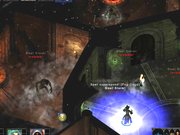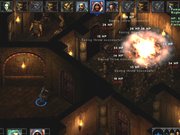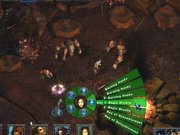The Temple of Elemental Evil Preview
Troika's next role-playing game will be based on a classic Dungeons & Dragons module. We get a hands-on look at the ongoing adventure.
Few studios have been so committed to free-form gameplay as Troika, the studio founded by three of the lead developers responsible for Fallout. That classic 1997 role-playing game and 2001's Arcanum were both built upon flexible skill and quest systems that let players choose their own path and had other characters react accordingly. While the original settings and rule systems in those games demanded an extra level of creativity from the designers, Troika's next game will be just as free-form but takes advantage of the newly revised Dungeon & Dragons 3rd Edition rules (also known as "3.5 Edition") and is faithfully based on a classic (and long-out-of-print) pen-and-paper adventure created by Gary Gygax. The Temple of Elemental Evil is entering the final stretch of a comparably short 18-month development cycle, and we've had the opportunity to play through a short section of a pre-beta version.

The Temple of Elemental Evil is a game that serious Dungeons & Dragons fans should be able to appreciate simply for the faithful re-creation of this classic module set in the world of Greyhawk. It's also the first game to use the just-released "3.5 Edition" rules, which, according to Troika's Mike McCarthy, streamline the Dungeons & Dragons setting to work well in a computer RPG. But while some familiarity with Dungeons & Dragons will make it easier to navigate the long lists of spells, skills, and feats available to you as you build a party of up to five characters, the game's interface doesn't let the details get in the way.
Even though you'll control a group of up to eight members, including a maximum of three hirelings, the mouse-driven interface is particularly easy to learn. All character actions--including various movement options, special combat abilities, thieving skills, and spells--are made available in a radial contextual menu that you can pull up at any time. Only the main categories are represented by icons, and as you move your mouse pointer over options on the circular menu, the detailed options are spelled out with text descriptions, so you don't have to remember the specific icon that represents the chain lightning spell, for instance. Even better, you can hotkey abilities for specific characters to skip a few steps, and the most basic actions, like moving and attack, can be executed with a simple left mouse-click. The interface elegantly color-codes actions so you see exactly what you can do in a turn, makes it easy to set up waypoints to avoid enemies, shows you the exact range of an area-effect spell like a fireball and who will be affected, and lets you pick targets for individual magic missiles and chain lightning bounces.

This system really seems to come into its own when combat begins. Many of the turn-based battles can be resolved quickly, but when things get tough, the fighting gets very suspenseful, and the game's wide range of advanced options seem quite welcome. The game starts your characters out at level one and limits their advancement to level 10, so individual party members won't ever get overwhelmingly powerful, at least not against the fearsome threats you'll meet. In the early level we played through, there were several encounters that were rather challenging; they rewarded careful use of team tactics and swiftly punished careless mistakes. The combat makes tactics feel important because you'll see every swing and spell that monsters send your way, and you'll flinch at the serious damage they might inflict. You might not waste time sneaking into a room to ambush a bunch of zombies, but intelligently handling a big ogre can keep you from having to reload a saved game or see a party member fall in battle.
Evil's Many Faces

Even though we were able to try only a small portion of the game, we discovered at least a few instances where it was possible to approach situations in different ways; for instance, in several situations, we had the choice of either speaking with characters to get extra information to avoid combat, or simply attacking everything in sight. But this is just one of the many choices you'll have to make in the full game. Simply choosing what kind of party you want to play will decide at which starting location you'll begin your adventure. This is where party alignment comes into play: Instead of letting evil and good characters mix improbably, the game requires you to pick one of the nine conventional Dungeons & Dragons ethical alignments for your entire party; that is, chaotic, neutral, and lawful variants of good, neutral, and evil.
There are nine starting vignettes that quickly present the motivation that gets a good or evil character involved in seeking out the mystery of the Temple of Elemental Evil, which is rumored to contain the spirit of an evil queen. Kindly adventurers may start the game out with a good deed and set off to destroy the source of local monster attacks, while less-benevolent characters may kick off their adventure with a killing spree and jump at the chance to harness the temple's evil power for their own. Troika also promises multiple endings for the game depending on your party's alignment and how you've played through the adventure.
The preview version we played seemed to include a good variety of creatures to fight, including giant frogs, which emerge from nearby boggy water with a splash. These aren't ordinary frogs--they have a nicely animated tongue attack that can incapacitate one of your characters, and they can even swallow a character whole. We also encountered a range of more-ordinary threats, like large rats and lizards, zombies, bugbears, and an unsavory group of human guards that serve the priest Lareth. These low-level opponents gave us an idea of the game's combat, but McCarthy showed us some of the more impressive creatures later in the game, such as air and earth elementals, an abyssal vrock, and a balor demon. These powerful creatures show off the game engine's good-looking particle-based effects, which are used for glowing spell effects and for swirls of fire and smoke. The Temple of Elemental Evil can look quite good, thanks to its 3D characters, dynamic lighting, and detailed prerendered environments. But there also seem to be moments when it's hard to see what's going on in the fixed-perspective isometric view, particularly when it's dark, when there are lots of creatures crowded together, or when characters are just behind a wall--hopefully the game's art team will address these issues before the game launches.

Troika's next game should provide a substantial adventure, considering that the game includes 100 maps of varying size to explore and 140 characters to meet. As the balor demon mentioned above and the screenshots suggest, the quest deep into the temple will take you to areas charged with magic and filled with danger. McCarthy said that completing the main quest will likely take anywhere from 30 to 60 hours, depending on how many side quests you decide to perform. A party of five characters that rush through the game may only end up at level seven or eight, but it's possible to play through the game with fewer characters to share the experience between fewer individuals. And you might really care about how strong your characters are at the end, because, if this game does well, Troika and Atari may release another adventure (possibly based on the classic Dungeons & Dragons adventure Against the Giants--another personal favorite of the developers) as a stand-alone game. And since Against the Giants is intended for characters from level 10 to 20, it makes sense to allow characters to be carried over. In the meantime, for those who might want more replay value than even the multiple story branches will provide, the game will offer the added challenge of an "iron man" mode--in this mode, if your characters die, they die permanently, and you can save your progress only when you quit the game.
The Temple of Elemental Evil is a very promising role-playing game that combines traditional Dungeons & Dragons rules with Troika's free-form role-playing design. The game is nearing its beta development milestone, and all features and content are complete. The entire development team will now focus on bug fixing and polishing for the next several months, and the game itself is scheduled for release in October.
Got a news tip or want to contact us directly? Email news@gamespot.com
Join the conversation